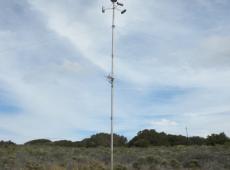The Fire Atmospheric Sampling System (FASS) was designed and built at the Fire Sciences Lab to sample gas and particulate emissions from prescribed and wild fires. It is deployed directly in the path of the fire to sample gas and particulate emissions. Typically two to four systems are installed on a site. The FASS consists of a tower with a sampling head at the top, and two instrument packages: one for real-time measurement of gas concentrations and another to collect canister samples of smoke. The FASS has been used to monitor and collect fire emissions in Africa, Brazil, Mexico, Alaska, and the western and southeastern US.
The FASS tower is 15 to 40 feet in height, depending on predicted flame lengths of the impending fire. The cylindrical head at the top has inlets for gas and canister sampling, anemometers to measure wind speed, Teflon filters to collect PM2.5 aerosols, and a thermocouple to measure air temperature. There are two sampling packages at the base of the tower, protected by fire shelters. The main package contains pumps that draw smoke through the tubing in the tower down from the sampling inlets for the filter sampling, and the gas sensors. The smoke passes through sensors continuously measuring carbon monoxide and carbon dioxide concentrations for the duration of the fire. Sampling is initiated by detecting an increase in CO2 levels at a programmed concentration emitted by the approaching fire. The other package contains a pump/ flow control system and four canisters to collect smoke samples for 3 combustion phases of the fire- flaming, intermediate, and smoldering. The canisters are analyzed at the laboratory by gas chromatography for CO2, CO, methane and other hydrocarbons. After the fire, data files are downloaded from the main package. The data files contain gas concentrations, filter flows, wind speeds, canister fill data, temperature, and system performance measurements.
